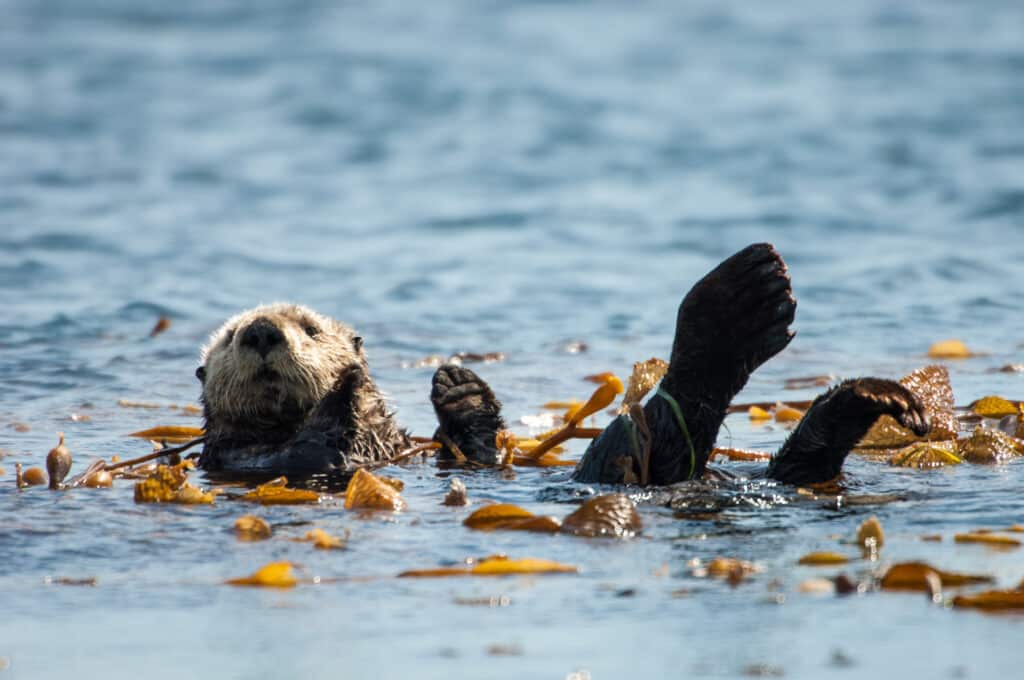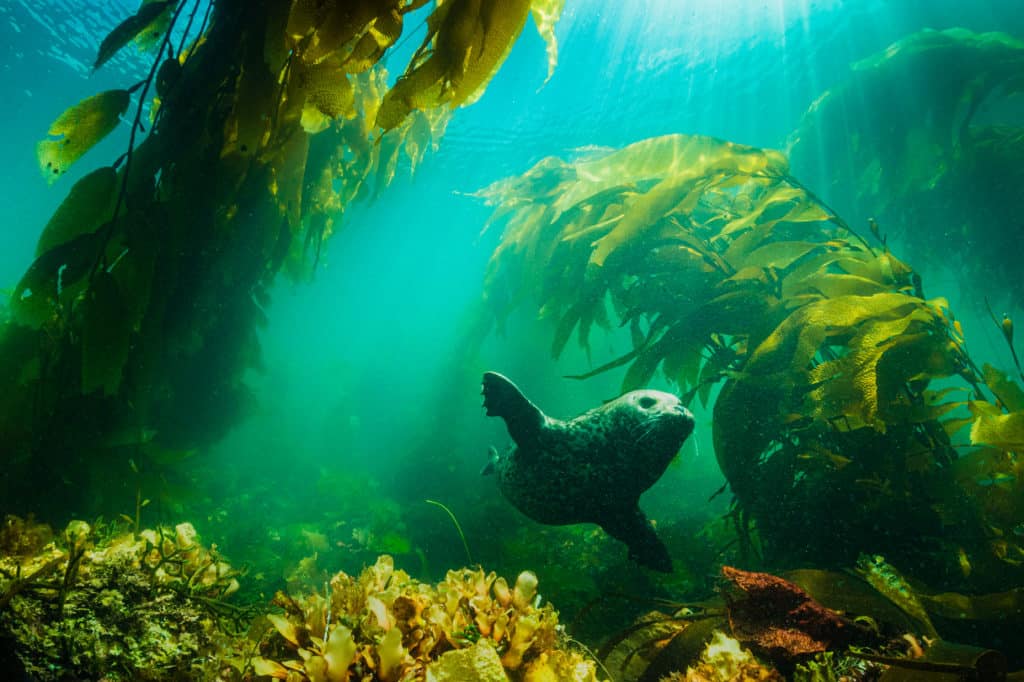The marine environment of the Great Bear Rainforest has few parallels in the world when it comes to biodiversity, richness and abundance. This July, our staff had an opportunity to visit some of the existing and proposed marine protected areas (MPAs) within the Northern Shelf Bioregion MPA network on the central coast of British Columbia (B.C) to. This is what they saw…
MPAs and MPA networks are put in place in areas that need established protection for long-term conservation of marine species, habitats, ecosystems and culture.
On the central coast of British Columbia (B.C) the wind whispers through the branches and boughs of old-growth forest, and the waves carry stories of ancient landscapes. Aboard a sailboat, our crew of five departed Denny Island, gliding through water of the darkest blue, surrounded by the lush green expanse of the Great Bear Rainforest. This journey is not just a voyage; it’s an odyssey of inspiration, a call to conservation, and a tribute to the existing and proposed marine protected areas in this region that safeguard our oceans and coastal communities.
Sailing through these waters is a reminder and a testament to the balance and stewardship that has sustained vibrant, diverse and resilient ecological communities for thousands of years. The air is alive with the calls of ravens, the cries of eagles, and the distant blows of humpback whales. Had we dropped a hydrophone in the water we undoubtedly would have heard the whistling calls of nearby Northern Resident killer whales who we spotted in the area, and who were following the salmon beginning to move inland in preparation to spawn.
Over the course of a few days we sailed through an interconnected network of some of the existing and proposed marine protected areas (MPAs) within the Northern Shelf Bioregion. These areas are nature’s safe havens, where marine life can thrive and ecosystems can regenerate. Just as protecting the trees of the ancient rainforest from logging are vital to its health, these underwater oases are integral to the resilience of the marine environment. The central coast has few parallels in the world when it comes to biodiversity, richness and abundance.
The importance of safeguarding these areas cannot be overstated. This journey prompts introspection and provides a chance to examine our role as members of the ecosystems we call home, that we rely on for so many essential services. We are reminded that just as a well-maintained sailboat navigates through rough seas, our efforts to promote marine conservation and enact positive change can steer us towards a sustainable future.
Before we even untied from the dock, we were already floating atop our first proposed protected area within the Northern Shelf Bioregion MPA network. As the journey unfolded we sailed through three interconnected MPAs proposed for the region. Connecting MPAs helps to safeguard the integrity of the marine environment and enhances the collective impact of these areas by creating larger and more viable habitat space for transient and migratory species. The objectives for these MPAs include: to conserve areas of high biological diversity, represent marine areas of high cultural or historic value and contribute to conservation of species significant to First Nations and coastal communities including those important for cultural use and food security.
The area we set sail on our first day of travel contributes to conservation of areas important for the life history of resident and migratory species protecting areas like estuaries, eelgrass beds, kelp beds, salmon and herring spawning grounds. As we floated along the surface, glimpses of the wonder lying beneath the hull of our vessel peek through the surface. A distant spout of mist rises into the air, catching the sunlight and creating a momentary gleam as a pair of humpback whales surface for breath. The ocean around the whales comes alive, reflecting their movements in shimmering ripples. The whales rise and fall in tandem, their blows like puffs of smoke against the backdrop of where the forest stretches right to the edge where land gives way to sea. Closer to the boat, salmon breach from the surface every few minutes, perhaps feeding on the same smaller prey species as the whales. We anchor for the evening in a secluded cove and awaken in the early morning to the calls of sandhill cranes. Lifting the anchor, we set sail again, leaving the shelter of nearshore islands and angling to a cluster of islands situated offshore.

En route to open water, we sailed through two existing MPAs and rockfish conservation areas (RCA) that currently contribute to protection of rare, unique, threatened, and/or endangered species and their habitats, including canary and yelloweye rockfish, Northern abalone, eulachon and sea otters. These protected areas are also in place to preserve cultural features and sites important spiritual relationships to the area, and areas used for teaching traditional practices. As a part of the Northern Shelf Bioregion MPA network, these areas may remain the same or receive additional protection and management measures to strengthen their effectiveness. Local intel informed us that there have recently been large rafts of sea otters sighted in the area and we kept our binoculars at the ready.
Since their reintroduction to British Columnia between 1969-1972, sea otters have begun to recolonize their historic range. Because adult females, the main demographic component of the population, exhibit strong site fidelity and occupy small life-time home ranges (rarely moving more than 20km from a location in a year) they have been slow to re-populate their entire historic range of coastal B.C. Extensive survey efforts along B.C’s north coast have yielded only four observations of single otters (during 281 km of survey effort north of Aristazabal Island), indicating that as of 2017 no significant further northward range expansion has occurred. In the ecosystems that they have recolonized, studies have shown that sea otters promote genetic diversity in eelgrass meadows, may yield 37% more total ecosystem biomass annually in coastal ecosystems they inhabit and can increase the value of finfish, carbon sequestration, and ecotourism.

The last stretch of journey this day took us across unprotected water, toward our final destination several miles offshore. On this day, the sea was extremely gracious. We felt only the light rock and roll of a gentle swell. Locally, this stretch of water is infamous for its unpredictable and often rough conditions. Nestled in the protection of the offshore islands, we set anchor again for the evening. We situated ourselves close to an area that, at low tide, reveals a land bridge in hopes of getting a rare glimpse of the coastal wolves that call these islands home. We would spend two days exploring the islands and cleaning up marine debris from the beach. Plastic water bottles and discarded fishing gear were unsurprisingly the worst offenders, washed in with storm surges and the high tide. Although we did not see any wolves on this visit, we did see lots of evidence of their presence including fresh tracks and scat.
The existing MPA/RCAs in this area contribute to conservation of a very high diversity of rockfish species, including a high abundance of shorter-lived rockfishes and habitat complexity. It also protects an important area for giant kelp and bull kelp distribution as well as steller sea lion and harbour seal haul-out sites. Hundreds of wide-eyed, cautiously curious harbour seals peer back at us from their underwater kelp cathedral. In visits past, Bigg’s (Transient) killer whales have weaved their way through the rocky outcrops surrounding the islands in search of such seals as prey.
This protected area also contributes to conservation of species significant to First Nations and coastal communities including those important for cultural use and food security. These species include barnacles, clams, mussels, cockles, crab, ducks, geese, rockfish, ground fish, sea lions, seals, marine birds, sea gull eggs, steelhead, and seaweed.

As we set sail once again, we caught the offshore wind and headed back towards the coast. On this part of our journey, we intended to weave inland through more protected islands and inlets. Returning from offshore and entering the gateway to the Great Bear Rainforest, we pass through a newly proposed MPA intended t0 protect natural trophic structures and food webs, from upper level predators to key forage species. This area is known to annually host herring spawn events that support significant wildlife aggregations.
This MPA also represents an area of high cultural or historic value and contributes to conservation of species significant to First Nations and coastal communities for cultural use and food security. By reducing or eliminating fishing pressure within their borders, highly protected MPAs in productive areas such as this provide a safe haven for species to grow larger and live longer, thus producing hundreds or thousands more offspring over their lifetime. This is just one of the rigorously studied benefits of MPAs that act like a bank account or an insurance policy for maintaining ocean resilience and productivity. Over time, well-managed MPAs secure a return on their initial investment in preserving biodiversity, biomass and generating economic stability for adjacent coastal communities.
Sailing deeper into the inlets and fjords of the Great Bear Rainforest the air presses in thicker and quieter around the boat with the breath of ancient, towering trees. We passed by salmon systems every few miles. Though we were there in advance of the annual spawn, it is easy to imagine the small rivers and streams swelling and overflowing as fish return, the satisfied huff of bears fattening up for the winter season, the calls of scavenging ravens, eagles and the yelps of excited wolf pups tasting salmon for the first time.
The three proposed MPAs within this region represent marine areas of high cultural or historic value to coastal First Nations, including seasonal camps, cultural features, important spiritual relationship and teaching areas. Ancient petroglyphs emboss the rock face between two sets of islands, with cedar posts rising from the tangled undergrowth, the last standing structures of village sites past. Voices whisper in the wind, carrying intimate knowledge and reverence of these waters and shores that have been passed down from generation to generation for thousands of years. In this place, so alive with history and tradition, we are reminded that although we are advocating for marine protection today, coastal First Nations have stewarded these waters and have supported abundant thriving ecosystems for thousands of years.

We dropped our anchor for the final night deep up the reaches inland of an inlet at the mouth of a salmon system that will shortly run silver with returning chum salmon. Rising early in the morning with the low tide we drank our coffee in the company of a particularly capricious couple of bald eagles. The drama of the day, as it seemed, was two uninvited juvenile eagles attempting to forage in the intertidal zone with the adult pair. After some time the juveniles gave up, leaving the adults to the bounty revealed by the tide. Retrieving the anchor, we set sail again for our last day at sea.
We passed through a final proposed MPA on our journey home: a stretch of water that connects the outer and inner coasts. A throughout fare of marine activity, this site has been chosen to conserve areas of high biological diversity important fish habitats and safeguard species including: steelhead, chum, coho, pink, and sockeye salmon, groundfish, quillback rockfish, marine mammals, marine birds and invertebrates such as cockles, purple-hinged rock scallop, Dungeness crab, spot prawn and the critically endangered sunflower sea star.
Our journey ends similar to how it began, flanked by breaching salmon and feeding humpback whales. The Great Bear Rainforest and its MPAs serve as both a backdrop and a reminder: that the beauty of our world is worth protecting, that our choices matter, and that by sailing forward with a sense of purpose, we can ensure that future generations inherit an ocean as vibrant and life giving as the one we are fortunate to explore today.

